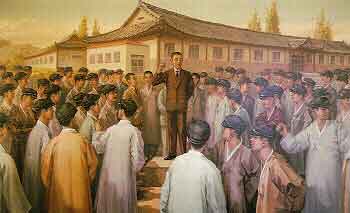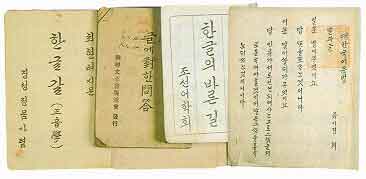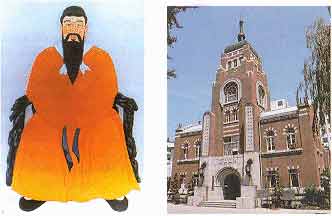| (1) Development of
National Education |
The enlightenment movement
came into being during the period when Japan's invasion
into Korea became evident and placed great importance on
the future of education. At the time, harbingers of the
movement wanted to safeguard the people. They held a
strong belief that the people's abilities should be
fostered through education for the construction of a
modern nation.
Thus, between 1905 and 1910, more than
5,000 nationalist schools were established at home and
abroad. New academic learnings along with national
history and Han'gul were taught at these schools for the
purpose of implanting a consciousness for
self-empowerment and autonomy as well as patriotism in
the heart of its students.
But after completely
robbing Korea of its sovereignty, Japan strongly
oppressed nationalist education and closed up many of
the schools. Japan strengthened colonial education in
order to demand subservience to Japan. |
| |
 |
As
the Japanese assault on the sovereign rights of
Korea began in earnest, many devotees of the
"Save-The-Nation Movement" established schools
across the country in an attempt to instill
patriotism among the
people. | |
| |
After a while, nationalist
education became active along with the rise of the
independence movement. Its leaders stood in opposition
to the government schools set up by the Japanese and
established private schools in various areas nationwide
to teach their students. Young leaders, who also shared
the nationalist sentiment, set up lecturing institutions
or night schools to teach poor youths in the cities and
villages. In spite of the Japanese oppression against
the traditional rural schools, Sodangs gathered students
from rural villages to nuture patriotism and teach the
basics of education.
Such active enforcement of
nationalist education at home and abroad not only aided
in preserving Korean culture but also played a decisive
role in training leaders of the independence movement.
|
| |
| (2) Research and
Preservation of National Learning |
| Following the development of
national education interest in the national language and
history also grew. Since the national language and
history are cultural heritages of the people, studies in
these areas became more active as a means of nurturing
nationalist sentiments among the people. This was at a
time when the Japanese oppression against the nation
increased in severity. |
| |
 |
An
organization dedicated to the study of Han'gul,
the Korean language, was established in 1921, and
Korean language scholars including Chu Si-gyong
actively promoted widespread use of the
language. | |
| |
A harbinger in these
activities, Chu Si-gyong passed on the results from his
successful studies and works to promote the national
language. He taught Korean to youths during the period
of the Patriotic Enlightenment Movement.
In addition,
the disciples of Chu Si-gyong set up the Choson Language
Institute to research and propagate the Korean language
even under Japanese oppression. The Japanese opposed the
study and use of Korean and threw many scholars into
prison (the Choson Language Institute
Incident).
Research in national history developed in
opposition to the Colonial Historical Perspective which
was written by Japanese government scholars. In order to
inspire a national consciousness, Sin Ch'ae-ho
systematically described our ancient history. Pak Un-sik
wrote a book on the modern history of Korea in order to
inform the world of the atrocities under Japanese rule
and the woeful independence movement of the Korean
people. These two persons were not simply historians but
were national leaders who offered their lives to the
independence struggle as they traveled to Manchuria and
China. Pak Un-sik was the president of the Provisional
Government of the Republic of Korea and Sin Ch'aeho was
a martyr who was captured by Japanese officials and put
into the L shun Prison for having participated in the
independence movement.
Japan, in an effort to fully
colonize the Korean nation, oppressed the study of
national history but also used every means to oppressed
its spreading. The Japanese even prohibited the use of
Korean at school and at home and prohibited people from
reading its history. But thanks to efforts of such
enlightened thinkers, Koreans were able to recover their
national language and history to take its place as one
of the most developed countries in the world today.
|
| |
| (3) Mass Media Activities
and the Art Movement |
During the Japanese
invasion, the leaders of the enlightenment movement
published newspapers and magazines to inspire patriotism
and bring modern thought to the nation. Such papers
include the Hwangsong Sinmun, Cheguk Sinmun, Taehan
Maeil-Sinbo, Manse-Bo and the Taehan Chaganghoe
Monthly.
Prominent enlightenment thinkers such as
Chang Chi-yon, Pak Un-sik, Sin Ch'ae-ho, Chu Si-gyong
wrote patriotic editorials for these newspapers and
magazines. For this reason, the Japanese closed down
these press agencies.
The Japanese, who were thrown
into shock by the Korean's will for independence through
the March First Movement, could not but permit the
publication of Han'gul newspapers and magazines. The
newly published papers during this period, such as the
Dong-A Ilbo and Chosun Ilbo, implanted a modern
consciousness in the people and greatly contributed in
inspiring the development of national
thought.
However, these papers were countlessly
suspended and confiscated as a result of Japanese
oppression and all of them discontinued by 1940.
As
the modern consciousness among the people grew, new
movements began to spring up in the fields of literature
and art. New novels, discounting feudalistic morality
and superstitions, were written during the patriotic
enlightenment period. In addition, Koreans also sang
songs which inspired a sense of independence and
patriotism.
Free development of such art activities
was impossible under Japanese rule. However, after the
March First Movement, some art magazines were published
and spurred new activities in literature and art. There
were some activists in this field such as Yi Yuk-sa, Yun
Tong-chu and others who displayed the joys and sorrows
of the nation, as well as the consciousness for
resistance. Thus, awakening these sentiments in the
people. Such endeavors in nationalistic art began to
fade during the 1940s due to Japanese oppression and
only the pro-Japanese art remained. |
| |
 |
Portrait of Tan'gun inside the main
Ch'ondo-gyo (religion of the heavenly way)
Temple. | |
| |
| (4) New Trends in Religious
Activities |
During the enlightenment
movement period, there were changes in the field of
religion as well. The thought of Tonghak, which was
greatly oppressed due to the peasant movement of 1894,
was redeveloped and expanded as a religion by the works
of Son Pyong-hui. However, as a minority of his
followers began to commit pro-Japanese acts, Son
Pyong-hui parted from them and created the Ch'ondogyo
religion which evolved from the traditions of
Tonghak.
Ch'ondogyo possessed a strong nationalist
consciousness which resisted the Japanese, and played a
pivotal role in the March First Movement.
Na Ch'ol
developed the nationalist worship of Tan'gun and founded
the Taejonggyo religion in 1909. Because it emphasized a
nationalist position, Taejonggyo was widely developed in
the Korean societies of Manchuria where armed
independence struggles were widespread.
Buddhism also
displayed changes concomitant with modernization. The
Buddhist monk Han Yong-un stood at the frontlines of the
March First Movement and Zen Buddhism, which was a new
formulation of Buddhism, carried out reclamation
projects and a movement to increase savings in order to
nourish the capabilities of the nation.
Foreign
religions in addition to national religions were
widespread. Through such education institutions, they
helped raise a modern consciousness and the desire for
independence among Koreans.
Japanese imperialists
similarly waged oppressive measures against religion. In
the process of invading the Empire of Taehan (Taehan
Chekuk), Japan suppressed Tonghak and created a
pro-Japanese religion of Sich'on'gyo (Heaven Worship),
and then they infiltrated into Buddhism and all chief
priests of important temples were appointed by the
Government General. Beginning with Sino-Japanese and
Pacific Wars, Japan waged an all-out campaign against
religion, forcing people to only worship the Japanese
gods. Japan deprived the Korean people of freedom of
religion and demanded that Koreans become its colonial
slaves by offering loyality only to their emperor.
|
| | |